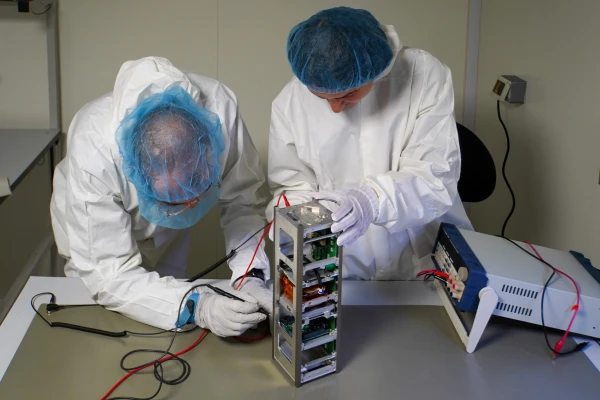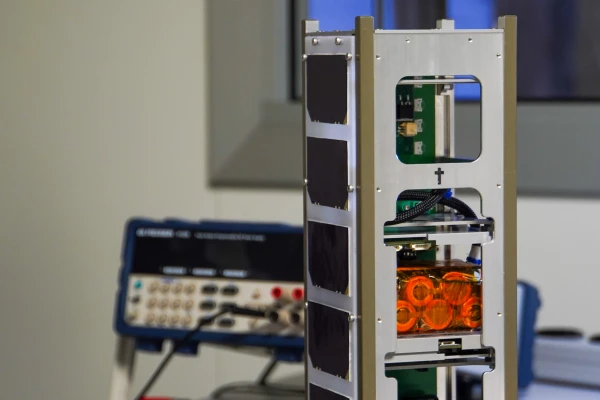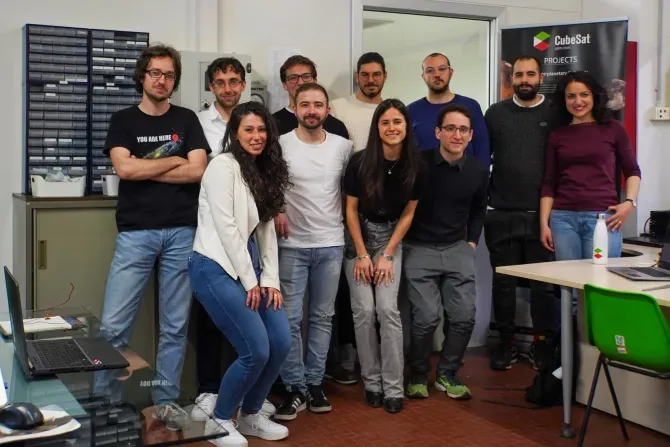 Students build the satellite for the “Spei Satelles” mission, Latin for “Satellites of Hope,” launched on a Falcon 9 rocket from the Vandenberg Space Force Base in California on June 12, 2023. Credit: Holy See Press Office
Students build the satellite for the “Spei Satelles” mission, Latin for “Satellites of Hope,” launched on a Falcon 9 rocket from the Vandenberg Space Force Base in California on June 12, 2023. Credit: Holy See Press Office
The miniaturized satellite, which can now be deployed into orbit from the rocket, holds a copy of a book documenting the pope’s urbi et orbi blessing of March 27, 2020, when, in the midst of the COVID-19 pandemic, he blessed the world from St. Peter’s Square with the words “Lord, may you bless the world, give health to our bodies, and comfort our hearts.”
“You ask us not to be afraid,” the pope prayed. “Yet our faith is weak and we are fearful. But you, Lord, will not leave us at the mercy of the storm.”
The book, “Why Are You Afraid? Have You No Faith? The World Facing the Pandemic,” has been converted into a nanobook, a 2-millimeter by 2-millimeter by 0.2-millimeter silicon plate, for transport to space.
Pope Francis blessed the satellite and the nanobook after his weekly public audience in St. Peter’s Square on March 29.
The Vatican said March 27 the CubeSat would travel aboard a Falcon 9 rocket, SpaceX’s partially reusable two-stage launch platform. It will be hosted on the ION SCV-011ION platform, a satellite carrier developed and built by the Italian company D-Orbit.
The Italian Space Agency will operate the satellite, which was built by the Polytechnic University of Turin.
 The “Spei Satelles” mission, Latin for “Satellites of Hope,” launched on a Falcon 9 rocket from the Vandenberg Space Force Base in California on June 12, 2023. Credit: Holy See Press Office
The “Spei Satelles” mission, Latin for “Satellites of Hope,” launched on a Falcon 9 rocket from the Vandenberg Space Force Base in California on June 12, 2023. Credit: Holy See Press Office
“The satellite is equipped with a radio transmitter as well as onboard instruments to be maneuvered from the ground,” a press release stated.




 Students build the satellite for the “Spei Satelles” mission, Latin for “Satellites of Hope,” launched on a Falcon 9 rocket from the Vandenberg Space Force Base in California on June 12, 2023. Credit: Holy See Press Office
Students build the satellite for the “Spei Satelles” mission, Latin for “Satellites of Hope,” launched on a Falcon 9 rocket from the Vandenberg Space Force Base in California on June 12, 2023. Credit: Holy See Press Office
 The “Spei Satelles” mission, Latin for “Satellites of Hope,” launched on a Falcon 9 rocket from the Vandenberg Space Force Base in California on June 12, 2023. Credit: Holy See Press Office
The “Spei Satelles” mission, Latin for “Satellites of Hope,” launched on a Falcon 9 rocket from the Vandenberg Space Force Base in California on June 12, 2023. Credit: Holy See Press Office


